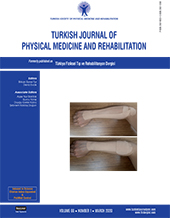Lower limb muscle activities and gain in balancing ability following two types of stair gait intervention in adult post-chronic stroke patients: A preliminary, randomized-controlled study
2 Department of Physical, College of Rehabilitation Science, Daegu University, Daegu City, South Korea
3 Department of Physical Therapy, U1 University, Young-Dong, South Korea
4 Department of Physical Therapy, College of Health and Medical Science, Daejeon University, South Korea DOI : 10.5606/tftrd.2020.3335 Objectives: This study aims to compare the changes in lower limb muscle activities after stair ascending and descending training at two different heights of stairs in patients with chronic stroke and to suggest a stair height which is more effective in improving the strength and balancing ability of these patients.
Patients and methods: Between November 2016 and February 2017, a total of 20 patients (14 males, 6 females; mean age 56 years; range, 52 to 61 years) with hemiparesis were included in this randomized-controlled study. The patients were randomly assigned to the 10- or 15-cm stair height group (10- and 15-cm groups, respectively; n=10 in each). Both groups received comprehensive rehabilitation therapy and additionally performed stair gait training for 30 min four times per week for a total of six weeks. Balancing abilities and the activities of the paralyzed lower limb`s rectus femoris, biceps femoris, tibialis anterior, and gastrocnemius during stair ascending were measured before and after the stair gait training.
Results: During stair ascent, the 15-cm group showed significantly greater muscle activities of the rectus femoris, biceps femoris, and tibialis anterior than the 10-cm group (p<0.001, η2=0.115; p=0.001, η2=0.022; and p=0.001, η2=0.036, respectively).
Conclusion: Our study results suggest that ascending stairs with 15-cm step height results in a greater muscle activity than with a 10-cm step height.
Keywords : Balance, chronic stroke, muscle activity, stair gait training, stair height

















